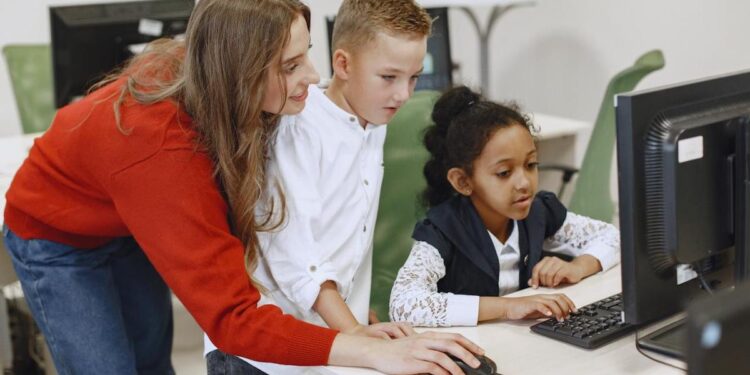When parents think about children and technology, they may think about the big bad screen and how their children may be addicted to it. However, responsible use of technology can actually accelerate learning and make it engaging for kids who are considered to be digital natives.
With a school’s strict guidance, and the additional oversight of parents, technology can play a crucial role in bolstering primary school curriculums and helping young kids learn about the world. Instead of banning screens, today’s teachers are embracing technology and the possibilities it holds for learning and teaching. Here’s an overview of how technology can be utilised in the elementary classroom and how it can be used to mould bright young minds:
1) It Provides a Plethora of Engaging Educational Activities
One of the most exciting transformations that technology has brought to the elementary classroom is increased student engagement. Instead of a teacher-centric approach where students are nothing more than passive participants in the discussion, they can now interact and actively participate in a plethora of new educational activities, courtesy of technology.
Through educational apps and multimedia content, elementary students are now more actively engaged in their learning journey. Whether they get to explore the depths of the ocean through virtual field trips or solve maths problems through interactive games, technology ensures that education is a thrilling and immersive experience for these budding learners.
2) It Facilitates Personalised Learning
In the traditional classroom, there are different types of students learning at different speeds. This is often cited as one of the problems with a school system adapted for the First Industrial Revolution. When educational pedagogy involves instructing students en masse, some will inevitably be left behind.
Adaptive learning software that incorporates adaptive pedagogic approaches can address this issue, using customised content and dynamic pacing that adjusts to meet individual students’ needs. This means that elementary students can also progress at their own speed and style. If a child needs more time to grasp a concept or is ready to move ahead, the technology used in the classroom can adapt to them and ensure that every student receives the education they need to thrive.
3) It Enables Remote Learning
While online learning technologies were already in use even before the COVID-19 pandemic, quarantines and lockdowns really pushed this technology to the forefront of almost every school. With just a stable internet connection and a mobile device, elementary students were able to continue their learning while inside their homes. Many families also relied on solutions like SIM only plans to get affordable 5G data plans for online learning.
This flexibility ensured that students’ elementary education remained uninterrupted, even in the most challenging circumstances. It’s sure to be of value in the future now that many schools are prepared to conduct lessons outside the physical walls of their classrooms.
4) It Provides Access to Digital Libraries
Imagine having all the world’s libraries in your pocket. That’s what technology brings to the table, and that’s a perk that today’s elementary school students can now enjoy.
Students can scour a vast array of resources, from e-books to research databases, and learn about virtually any topic of interest. This will not only enhance their academic knowledge; it will also hone their research skills and set them on a path towards becoming more independent and resourceful learners.
5) It Helps Students Develop Digital Literacy
It must be said that the internet is sometimes not a safe space for unsupervised kids. That’s why as early as in elementary school, teachers have taken the initiative to educate kids about digital literacy or how to use technology in a safe and ethical way.
An early education in digital literacy allows students to become proficient at using digital tools from an early age. More importantly, it also moulds them to become discerning internet users who can tell credible sources from unreliable ones. Indeed, digital literacy is no longer optional in today’s data-driven society, and even elementary school students should keep up in this regard.
6) It Fosters Creativity Through Digital Media
With the rise of new digital media technologies, budding student artists now have more avenues to express themselves. Through mediums like videos and digital art, students can present their ideas in innovative new ways.
For instance, they can animate their stories instead of merely writing them. They can also make their own digital portfolios of their artworks. Technology will allow them to cultivate their creative skills and find receptive new audiences for their emerging art practice.
7) It Opens Up Various New Resources for Teachers
While technology greatly benefits elementary school students, it’s equally transformative for teachers. For starters, it equips educators with more extensive tools for lesson planning, classroom management, and the like. Online, teachers can utilise educational apps and design beautifully customised materials for their discussions and class work.
8) It Strengthens the Connection between Parents and Teachers
The partnership between parents and teachers is crucial in a student’s educational journey, especially in the primary school stage. In this regard, technology serves as a bridge between the two, enabling seamless communication and collaboration about a child’s education and well-being.
Using messaging technologies and more, parents can stay informed about their child’s progress, access assignments and grades, and participate in extensive discussions with teachers. This connectivity promotes parental involvement and ensures that education is a holistic and collaborative effort between those at school and those at home.
Technology can’t be put back in Pandora’s box and forgotten. The tech revolution for education is already here, and it’s here to stay. Now’s the time for educators to harness the power of technology for elementary education, and for parents to participate in this new pedagogical model so that they can better guide their children.


